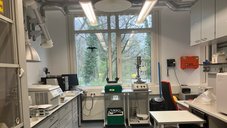Sediment Laboratory (SedLab)

Tracking Earth surface processes through size and shape of sediment particles
In the SedLab, we analyse the compositional properties of sediments by measuring the full range of grain-size distributions from a few nanometers to centimeters and by determining the shape of single grains. This allows us to determine the processes that have generated and transported sediments.
The SedLab is equipped to measure large batches of samples in either dry of wet conditions. The CamSizer allows us to determine the size and shape distributions in coarser (non-cohesive) sediments. It is particularly adapted to analyse sand-size aeolian or fluvial sediments. The laser diffraction analyser Horiba LA950V2 allows us to measure the grain-size distribution of sediments in solution. This is required for finer (cohesive) particles and if often applied to analyse mud- to silt-sized sediments of various origin.
A pretreatment is sometimes required to remove organic matter or (biogenic) carbonates or to disperse cohesive (clay) particles. This step can be performed in our lab in clean fume-hoods. Our team can advise on methodological requirements and can help develop specific measurement protocols. We can also assist with the statistical analyses of results as well as their visualisation.
Any inquiry about analytical possibilities and discussions of project ideas should be directed to C. Blanchet.
We have a fully equipped laboratory to process sediment samples with two work-spaces for sample preparation and two computer work-spaces for analytical analysis and evaluation. The lab is fitted with all equipment to chemically and physically prepare sediments for analyses. We have shaking tables, a fume hood and large drying cupboard for fast sample throughput.
The Retsch CamsizerXT analyses the the size and shape distribution of dry sediments. The device uses a high-speed image analysis to measure in real-time the size and shape of several million grains. Two high-definition cameras are taking pictures of the projected shadows of each grain that is analysed. The software instantly calculates the grain-size distribution and computes several shape parameters. We have two modules to disperse the grains for analysis one is a free-fall chute and the second is an air pressured accelerated chute that separates particles and aggregates. The measurement range of this device is between 10 μm and 3 cm. Due to the optical resolution limits the measuring range of the Camsizer can not cover clays very well and is more suited for coarser granulometries.

The Horiba LA950 laser-diffraction particle-size analyser that uses the static scattering of laser light beams by particles of different sizes. The basic physical principle is the Fraunhofer Theory after which the intensity of scattered light depends on the particle size. A second theory describing the scattering of electromagnetic waves on spherical objects is the Mie Theory. The later one is better suited for the interpretation of fine particles. Both models are automatically implemented in the measuring routine of our device. The advantages of static light scattering are that only a small amount of sample is needed for measuring a wide grain size range. In the SedLab we can measure grains in the size range of between 100 nm to about 3 cm. Our device is equipped with an autosampler that allows us to run large batches of sediments and maximise sample throughput.


